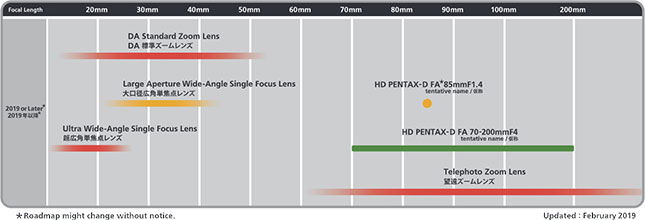Medium-format DSLRs are coming, and mirrorless converts will return! Ricoh Q&A from CP+
posted Tuesday, May 14, 2019 at 5:01 PM EDT

Recently, I had the opportunity to meet with executives from Ricoh -- the company behind the Pentax brand -- alongside the CP+ tradeshow in Tokyo. Speaking on behalf of both brands were Ricoh Co. Ltd.'s Takashi Arai of the Product Planning Department, Product Development Center, Smart Vision Business Group; Hiroki Sugahara, General Manager of the Marketing Communication Department; Yuusuke Shimizu of the Product Planning & Management Section, Theta Planning Department, Theta Business Division, Smart Vision Business Unit; Thijs Ekelschot, Head of Global Marketing; and Hiraku Kawauchi, Group Leader in the Public Relation & Advertisement Group, Marketing Communication Department.
For this interview, I focused in particular on Ricoh's plans for Pentax in the medium-format, full-frame and APS-C markets, as well as how the rather DSLR-centric brand plans to proceed in the face of soaring mirrorless camera sales. We also discussed the Ricoh Theta series of 360-degree spherical panoramic cameras, and especially the impressive Theta Z1, which serves as the line's new flagship. And we also talked about the extremely consistent design of the Ricoh GR series, how the company's detail-enhancing Pixel Shift Resolution technology has been received by photographers, the uncommonly broad scope of its overall product lineup, and plenty else besides.
But enough preamble, let's get right to the interview. (And once you're done reading, be sure to share your thoughts in the comments section at the bottom of the page!)
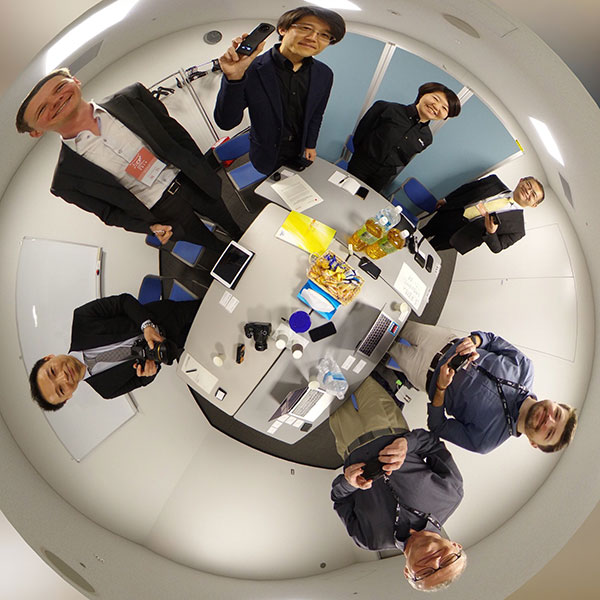
Dave Etchells/Imaging Resource: Our first question is a simple one, just about design on the GR-series. A few readers have pointed out that the original Ricoh GR, GR II and GR III are visually almost identical. Was that extremely consistent look an intentional aspect of the design, and do you think it's confusing to some users? What can you say about the GR-series design, generally?
Takashi Arai/Ricoh: Regarding the design, it's not only [similar] between the GR and GR III, but historically, the design of the GR [-series] from the time of the GR Digital didn't change so much. Actually, at the beginning of the product development, we [created a range of] designs, including more radical ones to [more] traditional, like the GR look. And we did some general enquiry...
Dave Etchells: Ah, like focus groups?
Takashi Arai: Yes. And finally, we [decided] to pick this design.
Dave Etchells: Mmm. And so it was based on consumer reactions to different designs you showed them. There was a preference for that shape, and you feel like it has some brand equity, that that's what a GR-series camera looks like, and that's why you want to maintain that.
Takashi Arai: Yes, yes. So that's one thing, but one of the philosophies of the GR-series is to always challenge something new. So we try to put that idea [into] the design. That is also true. But design is [very] much related [to] the operability. And once we focus on that good operability, then eventually this design must...
Dave Etchells: It works.
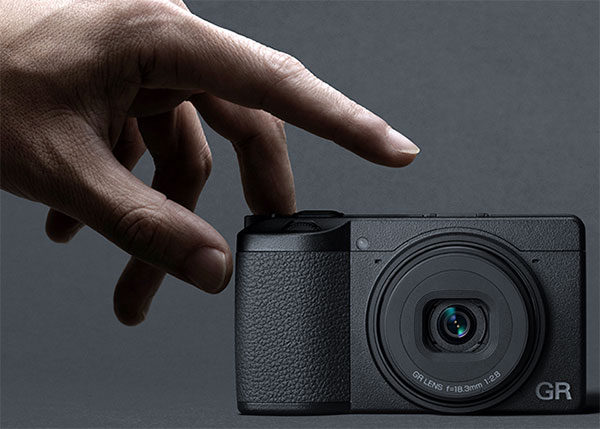
Takashi Arai: We thought [it's] the best.
Dave Etchells: Yeah.
Takashi Arai: So it comes back again to this design. I think what I meant is that we are not so much conservative about the design. We try to put more new ideas [into] the design, but the priority is the operability. And once we put that operability onto this camera, then...
Dave Etchells: As you look and you try a new design, you feel operability is not as good. So [the existing GR-series design] just ends up being a very good design, I suppose.
Takashi Arai: That's right. Now also we [care] much about current GR users. So that they would not mix up the operation of the new camera, that is also one thing we [cared] about.
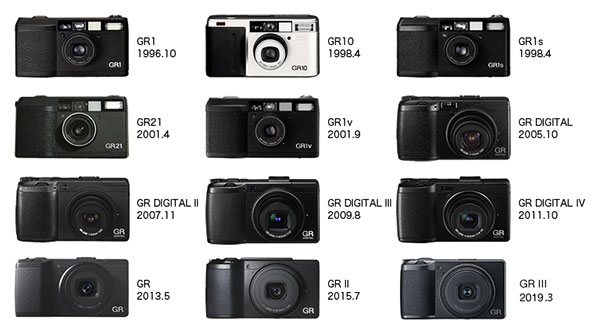
Dave Etchells: Mmm, yes. So switching topics a little bit, Ricoh was one of the early adopters of high-resolution shooting modes. I am curious, has Pixel Shift Resolution grown in popularity with your users, and do you see value in continuing to provide that feature in more models in the future?
Takashi Arai: Not [specifically] for the GR, but generally?
Dave Etchells: Oh, yeah, in general.
Takashi Arai: I think Pixel Shift Resolution is well-accepted, especially with photographers who specialize in landscape [photography]. Because the function is much [more] useful to take pictures of stable subjects.
Dave Etchells: Mmm, mmm.
Takashi Arai: Also, this technology comes from the sensor-shift technology, which is one of our unique points which many of our competitors don't have. So I'm sure that we will continue this technology on new models, yes, in general. But actually, the GR III doesn't have such a function, because it's best when the camera is fixed on a tripod, and the GR III is not [intended as a] camera to use with a tripod.
William Brawley: That's not traditionally a camera that's shot tripod [-mounted].
Dave Etchells: That's not its use case, yeah, yeah.
Takashi Arai: This is more [for] snap-shooting. This is one of the major reasons why we didn't apply that function on the GR III.
Dave Etchells: Hai, wakarimashita. [Ed. Note: "Yes, I understand."]
Our questions jump around a lot. When the Pentax 645Z was announced, it was way ahead of its time, and its price was very aggressive. It was giving a very high-quality 50-megapixel image so much cheaper than the competition. Since then, though, Hasselblad has announced the X1D, and Fujifilm has released their pair of GFX cameras. In particular, the GFX 50R is a new-generation camera, but it's about 10% less cost than the 645Z. What are your plans for your medium-format line, given the increased competition there now? It's been about five years since the 645Z was announced...
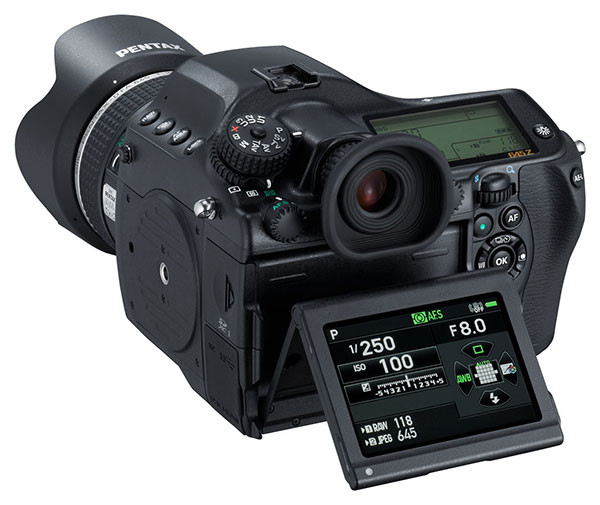
Takashi Arai: First of all, we'll continue the 645 line within the Pentax collection. But what we are going to compete against our [rivals with] is not the pricing, but the quality of the picture. [That's what's] most important within the camera. So we will still continue to study and produce a good camera with good image quality: That is also the same within the 645 medium-format line.
Dave Etchells: Mmm, mmm. So you're not trying to come out with a cheaper and cheaper model.
Takashi Arai: At the current moment, no.
Dave Etchells: You want to produce high-quality images, and let that sell the camera. Mmm, hai.
[This next question] is a little similar, but talking about the 35mm DSLR line. You released the K-1 Mark II last spring. Since then, Canon, Nikon and Panasonic have all released full-frame mirrorless cameras. Is the possibility of releasing a full-frame mirrorless camera something that has been explored within Ricoh, and what's your general strategy for mirrorless versus DSLR, going forward?
Hiroki Sugahara/Ricoh: Basically, we have been studying various formats and various systems, including mirrorless and also other types of systems. Any system, such as mirrorless or DSLR, has its own merits and benefits for users. For example, one of the benefits of DSLRs is that users can enjoy the shooting process by viewing the beautiful optical viewfinder. And on the contrary, of course, users can enjoy mirrorless cameras with easy operation [that provide a preview of] how the picture will [look] with an electronic viewfinder. Each system has its own benefits or merits, so we've been studying various possibilities. Currently, we [already] have various systems or formats, including medium-format, and also the high-end GR III system, and compact cameras, and waterproof cameras, and also Theta. <laughs>
William Brawley/Imaging Resource: Oh!
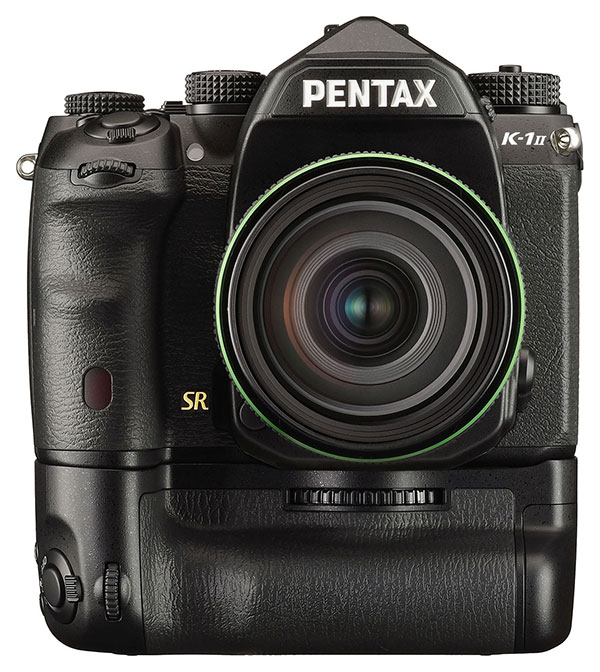
Although the nearly five-year old Pentax Q-S1 is still on sale in Japan, there are otherwise no mirrorless models available from the company any more, however. And if we limit ourselves to large-sensored cameras, Ricoh's last (and only) such offering was the Pentax K-01, a boxy and rather divisively-styled camera from 2012 that, while technically mirrorless, still kept the bulky mirror box to retain unadapted compatibility with DSLR lenses.
But while Ricoh and its Pentax brand don't currently have a mirrorless presence, nor any concrete plans for a return, the company tells us that it's still actively studying the market.
Hiroki Sugahara: But anyway, we've been studying various formats, including mirrorless. But currently we don't have...
Dave Etchells: There are no plans yet.
Hiroki Sugahara: No concrete plans, but we've been studying it, yeah.
Dave Etchells: Yeah, yeah. I hadn't thought in those terms: You've got six different camera lines, really, if you think about it. Medium-format, full-frame, APS-C, waterproof, GR III and 360.
Hiroki Sugahara: <laughs>
Dave Etchells: The engineers are already too busy.
<laughter>
Hiroki Sugahara: Actually, in the waterproof category, we have very many variations.
Dave Etchells: Mmm. There's a broad line with multiple models there, yeah.
Hiroki Sugahara: We [recently] announced two new models in the waterproof category, the Ricoh WG-6 and Ricoh G900.
Dave Etchells: Yeah. Well, Ricoh has been much more active in waterproof than anybody, really. Olympus has some products, but not many the way you do; they don't have a large line like that. How has that market been? Is it expanding, do you think, or...
Hiroki Sugahara: Regarding waterproof, the market size itself is steady. But actually the [market is moving towards] higher-cost models, so the average price is getting a little bit higher.
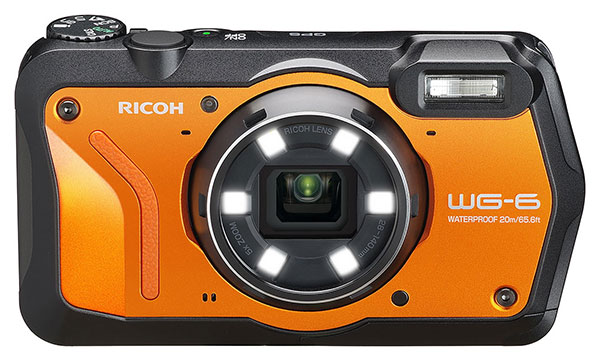
The model shown here, the Ricoh WG-6, actually traces its WG-series roots back to the Pentax WG-1, which first launched in early 2011. But that was hardly the start. In fact, the WG-1 was itself the 12th generation of Pentax's waterproof digital camera line, which began with the Pentax Optio 33WR way back in March 2003.
Dave Etchells: Oh, interesting. So the volume is the same, but the average price has been increasing.
Hiroki Sugahara: A little bit.
Dave Etchells: People are going to higher-end, more features. Interesting. Mmm.
This is maybe just another way of asking the question about mirrorless, but while the overall market for interchangeable-lens is decreasing, DSLR is decreasing more rapidly. How has that been felt within Ricoh, and what are the ways that you intend to combat that general decline?
Hiroki Sugahara: Currently, mirrorless is a newcomer, so of course many users are very interested in the new systems, they want to use [them]. But after one or two years, some users who changed their system from DSLR to mirrorless come back to the DSLR again.
Dave Etchells: Really?
Hiroki Sugahara: I believe. Because as I said before, each system has its own benefits or appealing points. The mirrorless camera is very convenient to shoot, because users can [preview the final] image before shooting. But I believe the DSLR has its own appealing point, because users can create their own image from the optical viewfinder. People can see the beautiful image through the optical viewfinder, and then think how they can create their pictures -- for example, exposure level setting or white balance or ISO [sensitivity] -- and then imagine how they can get [the result they're seeking].
Dave Etchells: Mmm, mmm.
Hiroki Sugahara: That is one of the big [advantages] of shooting [DSLR] cameras, so some users will come back to the DSLR system. But it might be they use both systems, DSLR and mirrorless. Because each system has its own benefits.
Dave Etchells: Yeah, yeah.
Hiroki Sugahara: So the DSLR market is currently decreasing a little bit, but one year or two years or three years later, it will [begin] getting higher.
Dave Etchells: You think it will return, will start growing again.
Hiroki Sugahara: Yeah. Yes, yes.
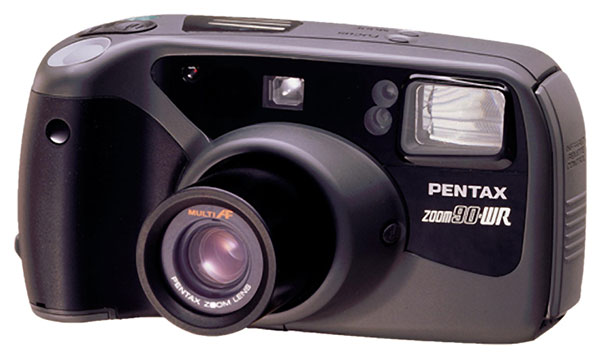
Dave Etchells: Hmm, interesting. I do think it's true that users don't decide they're going to go to a new system, sell everything they have and get it. Usually, they'll get a body and a lens, and then maybe they buy another lens, but it's not like they're typically throwing out their whole camera system.
Hiroki Sugahara: Yes, yes. So they have lenses for DSLR, so they can come back to DSLR easily. They can just buy a new DSLR body, and then they can easily come back to the DSLR system.
Dave Etchells: Mmm. In many cases, because mirrorless has a shorter flange depth, then they can also use their SLR lenses with mirrorless. And so in that way, too, it's another reason for them not to discard the SLR. They can use both systems as each is best.
Hiroki Sugahara:Yes, exactly.
Dave Etchells: So this next question is about market position, or the market segment that you're pursuing. In talking with Olympus -- especially when I interviewed Aki-san last October -- I asked how they felt about full-frame. They were very clear that their strategy is not to try to do that, but that their key factors are compactness, performance and weather-proofness. Aki-san drew a picture for me, and it was types of photography: One axis was still to moving subjects, and the other axis was indoor to outdoor subjects, and he identified that their target market is in the moving, outdoors area. And so for them, compactness and weather-sealing / ruggedness are two key parts of that. That's really where your APS-C line is, too; it's more compact and it's rugged. What are your plans for the APS-C line, and will it continue to be developed and presented as a more compact alternative for full-frame? How will you evolve that line, and how will you market it to customers?
Takashi Arai: So [among] the advantages that APS-C DSLRs can offer, we think that, yes, one of them is compactness, and also [higher speed]. We can use a small mirror mechanism inside, so the frames-per-second speed can be faster, theoretically, than [for] full-frame. So we will continue the development of APS-C DSLR models, and we are sure that model will have [the kinds of] advantages which the APS-C category [typically has].
Dave Etchells: Mmm, mmm. That's interesting. It's easier to make higher-performance APS-C DSLRs for the reasons you mentioned, so it would make sense that in the APS-C area, you would be coming out with advanced models that would be high speed, and that sort of thing.
This next question is maybe more in the technical back-end, but we're curious that Pentax-branded cameras have a very well-deserved reputation for weather-sealing and water-resistance, yet they also have very rich control interfaces. You have many buttons and knobs and things. It would seem that the more controls you have, the harder it would be to seal. Can you say anything about the engineering challenges of sealing a body that has that many, essentially, "holes" in it?
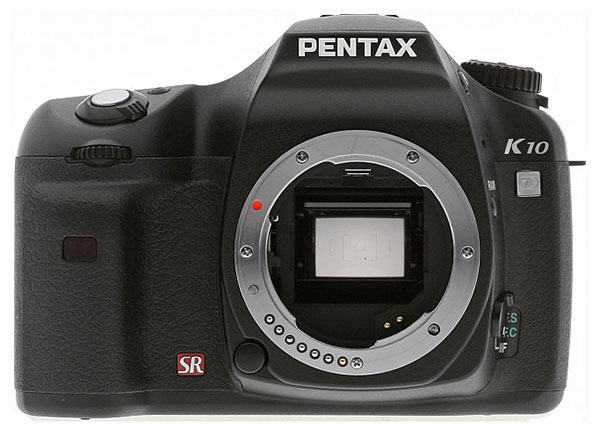
Takashi Arai: Yes, it's true that we have a reputation because of that water-resistant construction. Actually, the technological difficulty is not [in sealing] the buttons. Sealing the buttons is not that difficult.
Dave Etchells: Mmm. That's easy, because it's just a membrane, yeah.
Takashi Arai: The sealing on the moving dials or levers [is] difficult. But we have historical technological know-how from since the Pentax K10D, which we introduced in 2007...
Dave Etchells: Mmm, yeah. I remember that one.
Takashi Arai: ...so I think that is one of our technological advantages which other companies cannot easily imitate. And the philosophy behind [the decision to provide control-rich bodies despite the challenges in sealing them] is that we do not want to sacrifice operability for DSLRs. So this is the reason why, even [with] that kind of difficulty, we put an adequate number of buttons in the adequate positions. That is our concept behind that.
Dave Etchells: Mmm, and so basically, you have a lot of experience starting with the K10D.
Takashi Arai: Yes.
Dave Etchells: This next question is a technical one about image processing and image quality. Starting with the Pentax K-70, you had an accelerator unit (as you called it) in your processors, and it's also in the K-1 Mark II. When we compare high ISO images between the two cameras, with and without the accelerator, there's not only much less noise. The K-1 II has also eliminated a significant magenta color cast at very high ISOs, which the original K-1 showed. What precisely is happening with the accelerator unit, and how is it suppressing that global color casting?
Takashi Arai: So unfortunately...
Dave Etchells: You can't say details.
<laughter>
Takashi Arai: We are not able to give you much detailed information about what is happening within the accelerator unit. But one advantage because of the accelerator, is that it is not really necessary to put much noise reduction on the processor unit.
Dave Etchells: Ah, ahhh!
Takashi Arai: That is the major reason that we can get good image quality with the camera with accelerator unit. And this accelerator unit is Ricoh's proprietary technology.
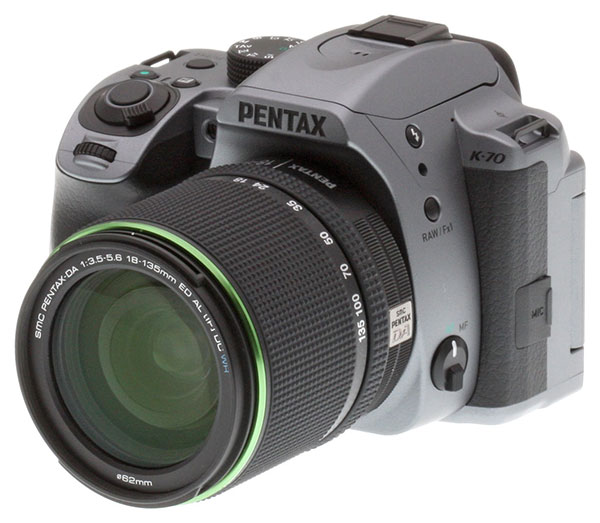
Dave Etchells: Oh, that's interesting. And so basically, the accelerator is doing all the hard work of noise reduction, and then the main processor is freed up to do other things. It can do color management or other image quality things.
Takashi Arai: That's right.
Dave Etchells: Ah, hai. So we're curious: The Ricoh Theta Z1 caught our eye and it looks great, but we wonder, it seems like kind of a risky product because it is around US$1,000, twice as expensive as the previous model. What's your sense about how popular it will be, and what are your projections relative to what it has been before? Because it obviously brings much better image quality and performance, but is that going to be enough for people to spend US$1,000?
Yuusuke Shimizu/Ricoh: So we have two one-inch image sensors included in this very small size, and the image quality's much better than the Ricoh Theta V. We think that that's quite enough for us. As a consumer camera, the cost is justified, yes.
Dave Etchells: Yeah, we were amazed that you could fit two one-inch sensors and lenses to do 360 [in such a compact camera].
Yuusuke Shimizu: We'd like to explain about the lens. We have three prisms there for each lens, so totally [for the camera] it's going to be six [prisms].
Dave Etchells: Hmm. Prisms meaning directing the light down [towards the base of the camera].
Yuusuke Shimizu: Yes. Bending the light.
Dave Etchells: Ah, so the sensors are down inside.
Yuusuke Shimizu: No. [They're] right here. [indicates the area directly beneath the two lenses and above the shutter button, with the two sensors mounted back-to-back in parallel with the optical axis shared by both optics]
Dave Etchells: There? Ah, wow! Three prisms for each lens.
Yuusuke Shimizu: Yes. You can see when you go to our booth, there is a transparent model.
William Brawley: I took a picture of that yesterday.
Dave Etchells: We took a picture, but we didn't realize quite what we were looking at.
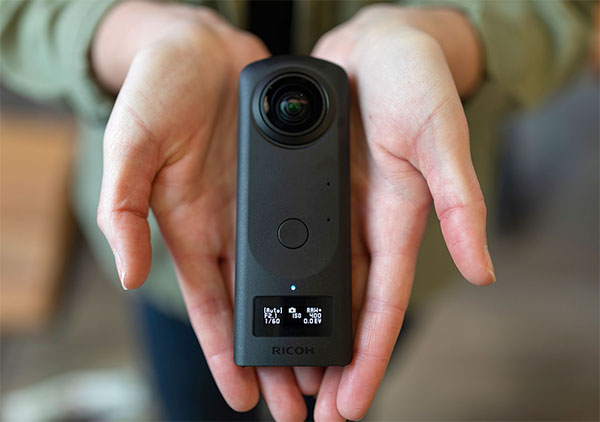
Each sensor sits behind a new lens and prism assembly which folds light in a C-shape, so it can be received by the sensors which are mounted centrally (and parallel with the optical path of the lenses), keeping body size to a minimum. The sensors aren't visible here, but lie beneath the body panel between the lens and shutter button in the image above.
Yuusuke Shimizu: So right [above the shutter button] there are two [vertical] lines [visible through the transparent body]. Those are the sensors.
William Brawley: Ahhh.
Yuusuke Shimizu: So the light goes in, down, and towards...
Dave Etchells: This is the body, and the sensor is oriented this way? [gestures to indicate a sensor mounted sideways inside the camera]
Yuusuke Shimizu: Yes.
Dave Etchells: Ahhh!
Yuusuke Shimizu: So that's why we have to bend three times [for each lens]. [Ed. Note: That's once to send the light from each lens' optical path sideways to the next prism in the chain, a second time to redirect the light from each of these prisms downwards for a short distance, and finally a third time to redirect the light back towards the centrally-mounted image sensors beneath both lenses.]
Dave Etchells: Yeah. Wow. That's crazy!
Yuusuke Shimizu: That's why we have this one-inch sensor, but it's this thin.
William Brawley: Yeah. That's cool.
Dave Etchells: I was surprised, but that makes it even more surprising. I would have thought with the one-inch sensor crossways, that you would need even more thickness there.
Yuusuke Shimizu: Usually when you bend [the light] too much, the image quality is affected. But with this one, we aligned it so that the image quality is very good.
Dave Etchells: Yeah, it must have to be very precisely-aligned prisms.
Yuusuke Shimizu: [Very] precisely, yes.
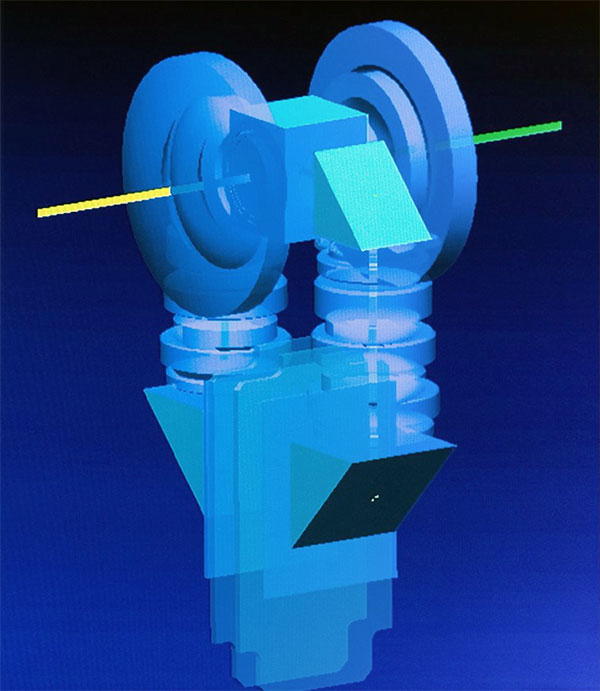
Dave Etchells: That's really fascinating, thank you for that information.
We're curious about the 360-degree video market in general. When it first came out it was a real novelty, and it seemed like it drew a lot of interest. But now, I don't see many 360-degree videos on YouTube. What can you say about how that market has evolved and changed? And also, is the interest different in different parts of the world?
Hiroki Sugahara: Basically the 360-degree image market, there are two big markets: The consumer [or B2C] market, and the business [or B2B] market. When I [speak] about the B2C market, actually the 36-degree moving video images, it is similar to the GoPro action camera images. People can enjoy the 360 images like a GoPro action camera image. They can shoot the 360 image, and then at home they can edit the 360-degree cameras any angle or any zoom...
Dave Etchells: They can choose where to look, yeah, yeah.
Hiroki Sugahara: Yes, and then [they can] change to the 2D movie image, and they can post to [social networks] or share...
Dave Etchells: So [we] may be seeing many 360 captured movies, but they're edited to 2D.
Hiroki Sugahara: Yes, edited to 2D. That's [a growing] use case, yeah. And the B2B business field, real-estate or inspection or construction, in those fields, B2B users shoot mainly still images, not video.
Dave Etchells: Mmm, and for that market, US$1,000 is not an issue. It's a commercial usage, and image quality is all-important.
Hiroki Sugahara: Yeah, very important. Also, we are hoping that professional still image photographers or high-end amateur photographers can enjoy high-quality 360-degree still images by using Theta Z1, because it has very good picture quality. So they can shoot 360 images, and at home with the PC, they can choose any view from their 360 image.
Dave Etchells: Yeah, yeah. It's interesting, I'd always thought of real estate, but then you mentioned construction or inspection, and those are really very big uses, I would think.
Thijs Ekelschot/Ricoh: We see four categories which [have] grown quite well in the US and in Europe. [In addition to those already mentioned,] it's also second-hand cars. We work directly with some brands or portals for the sales of second-hand cars. So this is all obviously the B2B side of the business.
Dave Etchells: Yeah. Ah, interesting. So they can put the 360-degree camera inside the car, and people can see the details.
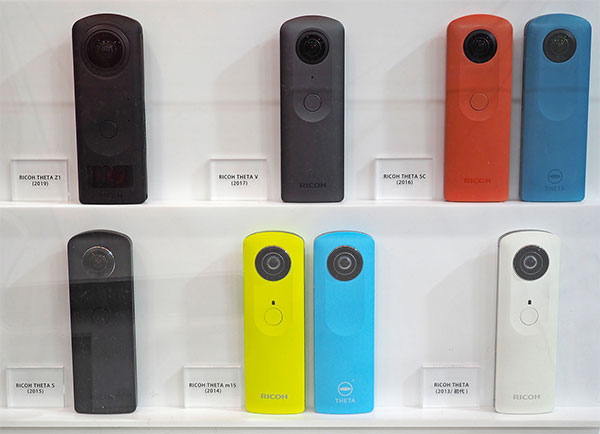
Yet were it not for the obvious difference in lens size, the Theta Z1 (top left) doesn't really stand out visually, alongside the models which preceded it. (That's the Theta V (2017) and a pair of Theta SC's (2016) at center and right on the top row, and the Theta S (2015), a pair of Theta m15's (2014) and the original Theta (2013) left to right on the bottom row.)
Thijs Ekelschot: Exactly. When you buy a new car, you know what it looks like. But for a second-hand car you want to double-check, and so we have some portals that now allow the 360-degree image being imported directly into their site. So when you look at the images of your second-hand car, you can also find a 360-degree image of the inside of the car, which is quite reassuring for many customers.
William Brawley: Mmmm.
Dave Etchells: Ah, that's very interesting.
Thijs Ekelschot: Like you have also, what Sugahara-san was mentioning on the real estate. When you buy an apartment, you want to look around, and with cars, this is also [true].
Dave Etchells: Yeah, yeah. Thinking about the use in construction, when we built our house -- this was many years ago now -- before they put the drywall on while it was just the studs, I took pictures of every wall so I could see where the wires were, and where the pipes were. So now, if I want to cut into a wall, I can look and see whether there's a wire there.
Thijs Ekelschot: [With Theta, that would be] one picture.
<laughter>
Dave Etchells: [For me] it was many pictures.
<laughter, crosstalk>
Dave Etchells: I took thousands of pictures, but I missed some areas, and then of course the first time I want to use it, it's like...
Thijs Ekelschot: You missed that!
Dave Etchells: ..."I can't believe I don't have..."
William Brawley: You only took 270 degrees. Didn't finish it!
Dave Etchells: But that's a good usage.
Thijs Ekelschot: Your question was also for video. We see quite a good distinguishing [line] between people that use it for video -- more for, let's say, capturing moments in people's lives -- and for still images being used in 360-degrees on certain portals. But you see a lot of keen photographers that would create a 360 image, and then [convert it to] a little planet, and so they are still making a 2D image out of this 360 image, but creatively, you know. For example, on Instagram it's quite popular, all these little planet images. And these are also users that we know would like a higher resolution of image quality, so...
Dave Etchells: Yeah, yeah. I'm, I'm really kind of surprised with 360 in general. It seemed to me that a very big market would just be memory recording. You know, you're going on a trip, and if you just had a 360... In fact, my wife and I after many decades are finally taking an anniversary trip to Italy and could use one ourselves. To be able to have a 360-degree image just as you're out with your family walking along, and then when you're back home [you can revisit the moment and] it's like "Oh, look what Johnny's doing over there," or "look at the people at that table." Years ago we went to Spain, and we were in a tiny little town and they had a rowing team that had just won, and so there's a huge celebration in the town and they had the oars crossed and the people walking underneath. I have some video of it, but I'm thinking "Gosh, it would be so cool to have a 360 of that." But it seems like I've never really seen that marketed very much, as a sales pitch to people to get them interested. Which surprises me, because it would be very, very interesting to me, and I would think a lot of people.
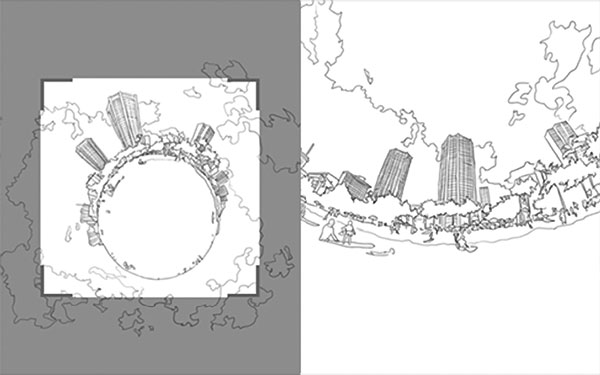
Yuusuke Shimizu: Yes.
Thijs Ekelschot: I think what we see a lot is that it's a different kind of photography and videography, because suddenly as a photographer, you are inside of the picture. And many photographers don't want to be in the picture. But you have also the bloggers and vloggers, people that actually don't mind when their face is being seen. For them, it's OK, but for the photographers, when they're inside the picture, they need to think twice how to make the setup, and...
Dave Etchells: Yeah, yeah. Still photography is all about creating an image, you're framing it, you're deciding what is going to be in it, and you do that before you push the shutter. With 360, you can still do that, but that happens afterwards, on the computer.
Yuusuke Shimizu: Yes.
Hiroki Sugahara: Yeah. And also, you can enjoy the VR goggles and people can re-experience that image with free angle.
Dave Etchells: Mmm, mmm.
Thijs Ekelschot: I don't know if you've seen that, but now you can install a plugin on the Theta, and the image that is on the Theta, you can see directly on your Oculus headset. We already had a plugin so you could connect your Theta to your TV, for example, so that you can show the image on the TV. But now also directly on the headset. That means that if you want to share the content, it becomes much more easy for people to see it.
Dave Etchells: Mmm, well that's cool. And that is actually a firmware plugin for the camera itself?
Thijs Ekelschot: Exactly.
Yuusuke Shimizu: With the plugin, you can see with Oculus and [other devices compatible with DLNA], so you can see it with PlayStation VR too.
Dave Etchells: We have just one or two more questions. In looking at your 360 cameras, it must take a lot of engineering effort, and so we wonder: Is that impacting your still camera work, because there's a lot of resources going into 360?

Hiroki Sugahara: Basically the Theta itself is developed by the Ricoh company. As you know, Ricoh and Pentax combined five years ago. We have another development team for the Theta, before five years ago, in the Ricoh company. So there's no impact to the development of Pentax-brand cameras, actually. [Of course,] the Theta team and the Pentax team and the Ricoh camera team are communicating with each other about technical information or picture quality.
Dave Etchells: Ah, so you have some efficiences because image-quality knowledge and processing can be shared now.
Yuusuke Shimizu: Yes.
Dave Etchells: That's interesting, that Theta was always a separate product from a separate team, so it's not like all of a sudden it comes up and takes everything away; it was always that way. That's good to know. We've got questions about lens roadmaps.
<laughter>
Dave Etchells: <laughs> I've said before, you know you're in trouble when they laugh at your question.
<laughter>
Dave Etchells: Well, I don't know to what extent you can answer: You have a lens roadmap showing five full-frame K-mount lenses scheduled for 2019 or later. But two of the lenses -- the 85mm f/1.4 and the 70-200mm f/4 -- they have full names now, and there's a woodblock of the 85mm f/1.4 [on the booth]. Does that mean that they are closer to being finalized? I know you can't tell me "Oh yeah, they're coming in June" or something, but does it mean that those will be some of the [next lenses to be released]?
(Click to see a bigger version of this image in a new window.)
Hiroki Sugahara: Actually, currently we are now developing the 85mm lens, but regarding the release timing, we can't say anything at this moment. Anyway, we are developing... <laughs>
Hiraku Kawauchi/Ricoh: We're working hard. We're doing our best, yes.
Hiroki Sugahara: <laughs>
Dave Etchells: OK. That's kind of an expected answer. I have to ask them anyway!
<laughter>
Hiraku Kawauchi: Of course.
Dave Etchells: The last question is not so much about timing, but about type: On the APS-C roadmap, there's a standard zoom lens. Can you say whether that will be more of a pro-level lens, or is it going to be like a new kit lens coming?
Hiraku Kawauchi: Secret. Still secret. <laughs> We have so many secrets. <laughs>
Hiroki Sugahara: Customers can expect... Highly expect...
Hiraku Kawauchi: <laughs>
Dave Etchells: They can highly expect a new product, you're saying, or they can expect a high-end product? Who knows. <laughs>
Hiraku Kawauchi: Mmmm! <laughs>
Dave Etchells: That's OK. Wakarimashita. I think that actually covers our questions.
William Brawley: Mmm-hmm.
Dave Etchells: Yeah. That was great. Thank you very much!
William Brawley: Thank you so much.
Hiraku Kawauchi: Thank you!
Summary
Perhaps the biggest "aha" moment of this interview for me was the realization of just what an incredibly broad camera lineup Ricoh has to offer. Between its own brand and that of Pentax, Ricoh has no less than three different DSLR lines: Medium-format, full-frame and sub-frame. On top of those, there's also the sub-frame Ricoh GR-series *and* the just-launched Ricoh Theta Z1 is also a large-sensor camera. And last of all, there's the waterproof camera market, where even Olympus doesn't quite match the breadth of Ricoh's offerings.
True, Ricoh has no presence in the fast-growing mirrorless market -- well, not outside of one now-ancient model that's available only in Japan, anyway -- and the company has no concrete plans to change that in the foreseeable future. But while Ricoh has seen a contraction in the DSLR market in the face of the mirrorless onslaught, it doesn't see itself as cornered. In fact, it's actually expecting sales to start growing again over the next few years, on the back of a return from some mirrorless early-adopters to the DSLR market. (Most likely, they'll be using both systems in parallel rather than retiring their mirrorless gear, we expect.)
Since there's a lot to digest in this interview, let's quickly break things down by category:
-
Medium-format: Ricoh are here to stay, and we can expect to see a follow-up to the 645Z in the fullness of time, but don't expect the company to participate in a race to the bottom on pricing. Although the Pentax 645Z was itelf very aggressively priced, Ricoh sees image quality as its best option for responding to the arrival of smaller, even lower-cost medium-format mirrorless cameras.
-
Full-frame DSLR: Right now, this is the sweet spot for most Pentaxians, with medium-format remaining out of reach for many. The flagship Pentax K-1 II is closely-related to the original K-1, and one of the key differences between the pair is the arrival of a new accelerator unit which works in parallel with the main PRIME IV image processor. (We saw this same chip previously in the sub-frame Pentax K-70.) While Ricoh understandably couldn't share too much detail here, we did learn that one important responsibility of the accelerator unit is noise processing. By taking on most of this workload, the accelerator unit allows more processor time for the main PRIME IV chip to be devoted to other image quality-related tasks.
-
Sub-frame DSLR: Pentaxians have been waiting a while now for a followup to the sub-frame flagship K-3 and K-3 II, as the Pentax KP which replaced them -- while certainly ahead on image quality -- does lag behind it predecessor in many other respects. Here, Ricoh reassured us that development of APS-C models continues apace, and offered a little insight into what we can expect: A focus on the format's key strengths of speed and compactness. But whether that means something more akin to the K-3 or KP-series, we can't yet say.
-
Sub-frame compact: In discussing the Ricoh GR III, we learned that its form is largely defined by function, which is why the series has stayed consistent in styling and basic layout through so many years and product generations. (Even if you go all the way back to the original GR1 film camera, it's still pretty easily recognizable as a member of the same family.) We also learned the reason that the Ricoh GR III lacks a Pixel Shift Resolution function, even though it has a sensor-shift stabilization system. Ricoh designed the GR-series with street shooters in mind, and while Pixel Shift Resolution can handle some subject motion and even handheld shooting these days, it's still predominantly a tripod-based technology that doesn't jibe well with a run-and-gun camera that will likely seldom come near a tripod.
-
Theta 360 cameras: Thanks to the new flagship Z1, the Ricoh Theta-series is the fifth section of the lineup to offer large sensors. (Specifically, a pair of 1-inch sensors that, while still small compared even to an APS-C format sub-frame sensor, are positively huge compared to the 1/2.3-inch sensors in most 360 cameras (and the Theta Z1's earlier siblings.) We also learned that a new triple prism-folded optical path has allowed these new, much larger sensors to be mounted vertically (and in parallel with the optical path of the lenses) allowing for a relatively minimal increase in body size. We further learned that while video is an interesting 360-camera feature in the consumer market -- where it's often edited back to a traditional 2D view post-capture so as to follow the primary subject -- for B2B sales it's actually still imaging which is the real meat and potatoes. That bodes well for the Theta Z1, with its focus on still image quality. And finally, for those of you who're not so enamored with VR and 360-degree content, well... you'll be glad to know that we learned the Theta is developed by a separate team within Ricoh that was already in place prior to the acquisition of Pentax, and so it won't have slowed development of your favorite interchangeable-lens gear in the least.
-
Waterproof cameras: And finally, we come to the weather-sealed compact camera line, which these days fall entirely under Ricoh's umbrella. And somewhat surprisingly, we learned that while Ricoh is seeing market size as fairly static here, it's actually seeing a small increase in revenue thanks to a shift towards higher-priced models. (We should also note that the company has been able to pool resources here nicely, combining the WG-series of consumer cameras it took onboard from its Pentax brand with its own industrial-friendly cameras. In the process, it's created two distinct product lines from a single shared body design and imaging pipeline.)
